Salang Tunnel
35°19′19.5″N 69°1′37.0″E / 35.322083°N 69.026944°E
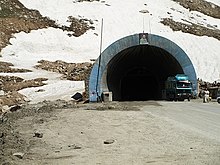
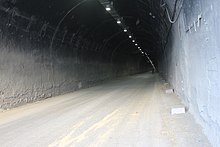
The Salang Tunnel (Dari: تونل سالنگ Tūnel-e Sālang, Pashto: د سالنگ تونل Da Sālang Tūnel) is a 2.67-kilometre-long (1.66 mi) tunnel located at the Salang Pass in northern Parwan Province of Afghanistan, about 90 km (56 mi) north of the nation's capital, Kabul. At nearly 3,200 m (10,500 ft) above sea level, the tunnel work was originally completed by the Soviet Union in 1964.
The Salang Tunnel is of strategic importance as it connects by road Central Asia with South Asia, and is the only pass going in a north–south direction to remain in use throughout the year,[1] although it is often closed during the cold winters by heavy snowfall.[2][3][4]
In 2023, major construction work was done inside and outside the tunnel.[5][6][7]
Overview
[edit]The tunnel represents the major north–south connection in Afghanistan, cutting travel time from 72 hours to 10 hours and saving about 300 kilometres (190 mi). It reaches an altitude of about 3,400 metres (11,200 ft) and is 2.6 kilometres (1.6 mi) long. The width and height of the tunnel tube are 7 metres (23 ft). Other sources say that the tunnel is no more than 6.1 metres (20 ft) wide at the base and 4.9 metres (16 ft) high, but only in the centre.[8]
It was noted in 2010 that about 16,000 vehicles pass through the Salang Tunnel daily.[9] Other reports say that the tunnel was designed for 1,000 vehicles a day, but is now handling seven to ten thousand vehicles a day.[8]
It forms part of Highway 1 (Ring Road).
History
[edit]In 1955, Afghanistan and the Soviet Union signed an agreement to initiate joint development of the Salang road, initially via the historic Salang Pass route. The tunnel was opened in 1964 and provided a year-round connection from the northern parts of the country to Kabul. The tunnel was the highest road tunnel in the world until 1973, when the United States built the Eisenhower Tunnel — just slightly higher and slightly longer — in Colorado in the Rocky Mountains.
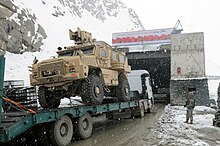
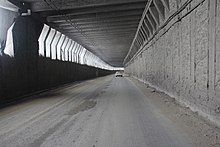
A ventilation system was built in 1976. During the Soviet–Afghan War, the tunnel was a crucial military link to the south, yet was prone to ambushes by the Afghan mujahideen fighters.
After the 1989 Soviet withdrawal from Afghanistan, maintenance suffered, and eventually, in the course of combat between the Northern Alliance and the Taliban in 1997–1998, the tunnel's entrances, lighting and ventilation system were destroyed, so that it could only be transited by foot in the dark. After the overthrow of the Taliban-led government in the 2001 US invasion of Afghanistan, a joint effort of agencies from Afghanistan, France, Russia, the United States and others cleared the mines and debris and reopened the tunnel on January 19, 2002.[2]
In the early 2010s it was still receiving ISAF funding for repair and renovation.[10]
In 2012, the United States Agency for International Development (USAID) made a technical study for a new tunnel reaching from the Olang region in Parwan province (about 6km south) to DoShakh in Baghlan province (about 10km north), going through the mountains of the Hindu Kush, further than the current tunnel. The design shortened travel distance by 30 to 40 km (19 to 25 mi).[11]
Incidents
[edit]1980 accident
[edit]On February 23, 1980 as a result of a road traffic accident, a Soviet Army convoy was trapped and 16 of its servicemen suffocated from exhaust gases.[12]
1982 fire
[edit]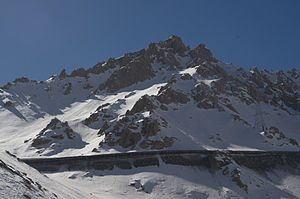
On November 3, 1982 a deadly fire killed an estimated 64 Soviet soldiers and 112 Afghans based on Soviet sources; apparently after a collision, a tanker truck blew up in the tunnel, and the fire engulfed a military convoy. Western sources estimate as many as 2,700-3,000 fatalities.
2002 avalanche
[edit]Several weeks after reopening several hundred people were trapped in the tunnel due to an avalanche at its southern end. While most people were rescued, some died from asphyxiation and freezing. After further rehabilitation in July 2004, the tunnel could carry two-way traffic.
2009 avalanches
[edit]Avalanches in the approach to the tunnel killed at least ten people in January 2009.[13]
2010 avalanches
[edit]On February 8, 2010, a series of at least seventeen avalanches struck the area around the tunnel, burying miles of road, killing 175 people and stranding hundreds more.[14][15][16][17] Hundreds of cars were buried in the snow.[15] At least 400 injuries were reported.[18]
The Afghan National Army and NATO used their helicopters to rescue at least 2,500 people who were trapped inside their vehicles.[15]
The avalanches were caused by a sudden blizzard that struck the area, closing the tunnel and the roads around it on both side of the tunnel.[14]
The tunnel was reopened on February 12, 2010.
2022 fire
[edit]On 18 December 2022, a fuel tanker exploded, killing at least 31 people and injuring 37 others.[19][20]
See also
[edit]References
[edit]- ^ "Salang Tunnel - Afghanistan's lifeline". BBC News. 10 February 2010. Archived from the original on 2013-03-06. Retrieved 2023-02-11.
- ^ a b Jerome Starkey (9 February 2010). "Avalanches kill 28 and injure dozens near Salang tunnel". The Times. Archived from the original on 2011-06-04. Retrieved 9 February 2010.
- ^ Bauer, Wolfgang (2022-04-17). "Salang-Tunnel in Afghanistan: Der Riss". Die Zeit (in German). ISSN 0044-2070. Archived from the original on 2023-10-30. Retrieved 2023-10-30.
- ^ "High Up In Afghanistan, A 'Ghostly' Ride Through The Salang Tunnel". Archived from the original on 2023-11-08. Retrieved 2023-10-30.
- ^ "80pc reconstruction work of Salang tunnel completed". TOLOnews. 26 October 2023. Archived from the original on 2023-11-13. Retrieved 2023-11-13.
- ^ "Mullah Baradar inspects Salang Pass reconstruction project". Ariana News. October 31, 2023. Archived from the original on 2023-11-13. Retrieved 2023-11-13.
- ^ "Workers Attempt to Finish Salang Pass Repair Before Winter". TOLOnews. 4 November 2023. Retrieved 2023-11-13.
- ^ a b Nordland, Rod (2012-06-02). "U.S.-Pakistan dispute chokes Afghan supply route". The Seattle Times. Archived from the original on 2016-04-01. Retrieved 2012-06-04.
- ^ IRINnews (February 15, 2010). "Lessons from the Salang pass disaster". Archived from the original on July 18, 2011. Retrieved March 7, 2010.
- ^ "ISAF finance Salang tunnel renovation". The Khaama Press News Agency. 2 March 2013. Archived from the original on 2013-03-04. Retrieved 3 December 2017.
- ^ "Technical Studies for New Salang Tunnel Underway". Archived from the original on 2012-04-29. Retrieved 2012-04-27.
- ^ "Афганистан". Archived from the original on 2008-05-11. Retrieved 2021-08-24.
- ^ "Afghanistan avalanches kill 10". The Belfast Telegraph. 2009-01-18. Archived from the original on 2016-08-01. Retrieved 2009-01-18.
- ^ a b "Afghanistan tunnel avalanches kill 24 in Hindu Kush". BBC News. 9 February 2010. Archived from the original on 2010-02-11. Retrieved 9 February 2010.
- ^ a b c Rod Norland (2010-02-09). "Avalanches Kill Dozens on Mountain Highway in Afghanistan". The New York Times. Archived from the original on 2010-02-19. Retrieved 2010-02-10.
Heavy winds and rain set off 17 avalanches that buried more than two miles of highway at a high-altitude pass in the Hindu Kush mountain range, entombing hundreds of cars and cutting off Kabul's heavily traveled link to northern Afghanistan, officials said Tuesday.
- ^ Faiez, Rahim (2010-02-09). "Avalanches swamp Afghan pass: Scores of bodies pulled from cars as coalition joins search for injured". Toronto Star. Archived from the original on 2016-03-06. Retrieved 2010-02-10.
A series of avalanches engulfed a mountain pass in Afghanistan, trapping hundreds of people in their buried cars and killing at least 24 people, authorities said Tuesday.
- ^ Ahmed Hanayesh, Ron Synovitz (2010-02-10). "From Afghan Avalanche, Tales Of Tragedy And Survival". Radio Free Europe. Archived from the original on 2010-02-12. Retrieved 2010-02-10.
By the evening of February 10, authorities had recovered the bodies of more than 160 victims buried by a series of avalanches. The stories told to RFE/RL by survivors suggest the death toll could rise as search teams continue their work—and when the spring thaw reveals the full extent of the tragedy. The first avalanche blocked the highway just south of the Salang Tunnel. As the traffic began to pile up, travelers in cars, trucks, and buses found themselves trapped in a deadly avalanche zone. Then, one after another, as many as 16 more avalanches wiped their vehicles off the road.
- ^ "Officials: Afghan avalanches may have killed over 60". Toronto Sun. 9 February 2010. Retrieved 9 February 2010.
- ^ "12 killed as oil tanker catches fire in Afghanistan's Salang pass". Brecorder. 2022-12-18. Archived from the original on 2022-12-18. Retrieved 2022-12-19.
- ^ Binesh, Banafsha (19 December 2022). "Death Toll in Salang Tunnel Fire Increases to 31; Casualties May Rise". Tolo News. Archived from the original on 2022-12-20. Retrieved 2023-02-11.
External links
[edit] Media related to Salang Tunnel at Wikimedia Commons
Media related to Salang Tunnel at Wikimedia Commons- The reconstruction project of the world's most dangerous tunnel in Afghanistan. on YouTube
